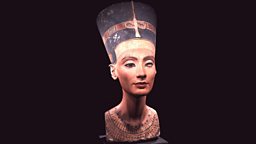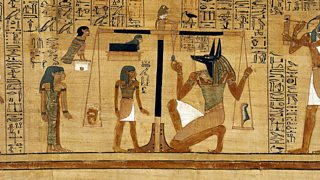Nine cult Ancient Egyptian figures that pop up everywhere
In The Cult of King Tut Patricia Clavin explores the explosion of Egyptomania following the opening of King Tutankhamun's Tomb in 1922. But who was Tutankhamun? And what about the other Ancient Egyptian celebrities whose names we’re so familiar with like Cleopatra, Nefertiti, Isis and Ra?
Here’s our pick of the famous Ancient Egyptian inhabitants and some of the great deities they worshipped.

-
![]()
The Cult of King Tut
Patricia Clavin explores the cult of Egyptomania following the opening of King Tutankhamun's Tomb in 1922.
1. Tutankhamun
Tutankhamen, often referred to now as King Tut, is the most well-known of Egypt’s pharaohs due to the 20th century discovery of his remarkable tomb. Inside a stone sarcophagus were three more coffins, with the final gold coffin containing the mummy of King Tut himself – perfectly preserved for more than three thousand years!
Despite his fame today however, King Tut’s rule was very short and he had little impact on Egyptian society. He was actually just a boy king – crowned age nine or so – and he died at the young age of 19 after just ten years of rule.
However, some believe he may be having more of an influence from the afterlife… When a number of people died after coming into contact with his tomb a rumour grew that the pharaoh had unleashed a powerful curse upon all who dared disturb his slumber…

2. Anubis
Anubis was the god of death, mummification and embalming.
He had the body of a man but the head of a jackal, black to symbolise decay and with proud, erect ears.
Since jackals were often seen hanging around tombs and graves (in the hope of an easy meal), it was believed that Anubis watched over the dead.
And according to legend, he was the one who invented the process of embalming bodies to preserve them. Which became quite a thing for the Ancient Egyptians, as King Tut’s remains would demonstrate.
-
![]()
In Our Time: The Egyptian Book of the Dead
An ancient Egyptian collection of spells intended to assist the journey of the deceased through the underworld.

3. Nefertiti
Nefertiti was the wife of the Egyptian pharaoh Akhenaten, and had six daughters by him.
She was renowned for her beauty and made famous by her bust, which was discovered in 1912 in the workshop of an Ancient Egyptian sculptor.
Nefertiti and her husband were behind a religious revolution. Previously, Egyptians had worshipped more than one god, but the pair made their subjects venerate just one — the sun disc Aten.
Nefertiti – also known as Hereditary Princess, Great of Praises, Lady of Grace, Sweet of Love, Lady of The Two Lands, Main King's Wife (the list goes on!) — was one of the most powerful women in the history of Egypt, but her mummy has never been found.

4. Ra
Ra, the sun god, was depicted as a human with a falcon head, and crowned with a sun disk encircled by a cobra. He was often shown holding one of the most recognizable symbols from ancient Egypt, the Ankh or “the key of life”.
The solar deity was a pretty big deal for the Ancient Egyptians. In fact, they believed that he was behind the very creation of the world.
He became so important that the Pharaohs took to calling themselves the “Sons of Ra” and they spent much of the kingdom’s cash on sun temples, pyramids, and obelisks – all built in his honour.

5. Ramses II
Pharaoh Ramses the Great had a bit of a thing for monuments. In fact, he built more architectural structures than any other king in the history of Egypt, many of which can still be found in the country today.
Ramses II is considered one of the greatest rulers of Ancient Egypt, for his military prowess as well as his construction record.
He stuck around too – he died at the ripe old age of 92, after 67 years on the throne. And during that time, he had more than 100 children!

6. Osiris
Osiris is one of the most easily recognised of all the Egyptian deities because he took human form (no animal head here) and had a rather striking plaited beard (not a look that’s caught on). He also had a tall headdress called the Atef crown and carried the flail and the crook, symbols associated with royalty and often depicted in the hands of the pharaohs themselves.
Not seemingly worried about getting hitched too close to home, he married his sister Isis to have his son Horus, and had another son, Anubis, by his sister Nephthys. Sadly, he was murdered by his jealous brother Seth – the upside being he became the lord of the Underworld.
Osiris was possibly the most popular and enduring of all the Egyptian gods – his worship lasted thousands of years.

7. Isis
Isis was a caring, maternal goddess who had love for all. She was said to protect children and magically heal the sick.
The Egyptians viewed her as a protector and the mother of the Pharaohs and, along with her sister Nephthys, she appears depicted on many ancient coffins. It was thought that these pictures would help protect the resident dead from evil. Four statues of Isis guarded Tutankhamun's own famous shrine.
8. Horus
Horus was the son of Isis and Osiris (who we’ve established were a little too closely related) and the god of the Sky. Like Ra, he had the head of a falcon.
After fighting his envious uncle Seth, he became the king of Egypt – but, unfortunately, he also lost his eye during the battle. The Eye of Horus became one of the most important symbols in Ancient Egypt. As an amulet it was thought to fight off evil, danger and disease.
The symbol of the Eye of Horus – also called the Wadjet Eye – was often painted on boats to protect them in violent seas.
Horus was another stalwart amongst the deities – he was worshipped from the very beginning of the ancient Egyptian period, right through to the end.
The Eye of Horus


9. Cleopatra VII
Everyone’s heard of Cleopatra. Not least because of Shakespeare’s play or Elizabeth Taylor’s performance (and iconic make-up) in the Hollywood movie. But who was she really?
Well firstly, she wasn’t actually Egyptian. She was a member of the Greek Ptolemy family that had ruled Egypt for 100 years after it was conquered by Alexander the Great.
Cleopatra was well-educated, intelligent and ambitious, but when she became queen of Egypt at eighteen law prohibited women from ruling so she was forced to share her position, first with her brothers and then later her son. Although, she undoubtedly wore the trousers in all three of her co-regencies.
She is famous for her seductive power and romantic liaisons, first with Julius Caesar with whom she had a son and then after Caesar’s murder, with Mark Antony.
When Cleopatra’s second husband died, she (rather dramatically) opted for suicide by snakebite. Cleopatra was the last pharaoh of Egypt. After her death, Rome took the reins.
-
![]()
In Our Time: Cleopatra
The Egyptian pharaoh whose charisma, intelligence and beauty made her one of the most celebrated rulers of the ancient world.
More from Radio 4
-
![]()
The Cult of King Tut
Patricia Clavin explores the cult of Egyptomania following the opening of King Tutankhamun's Tomb in 1922.
-
![]()
In Our Time: Ancient Egypt
Browse the Ancient Egyptian era within the In Our Time archive.
-
![]()
How ancient civilisations helped build our modern cities
The modern-day, town planning legacies of the ancient world, from pagan Britain to Babylon.
-
![]()
You're Dead To Me
The history podcast for people who don’t like history… and those who do.





